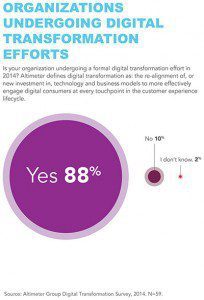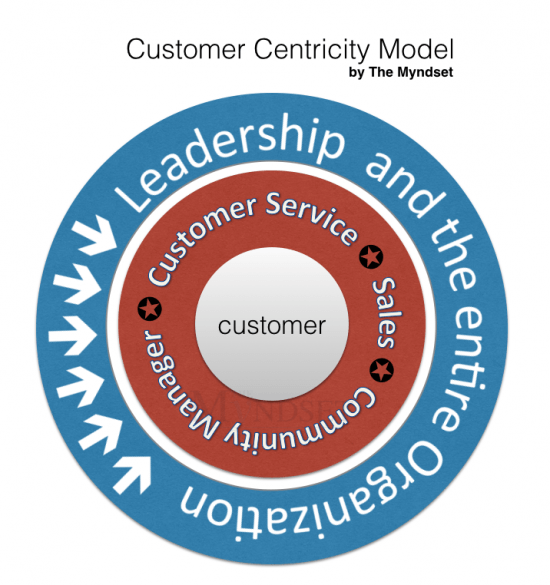
If you are exploring a digital transformation process, there are two important things to know:
- The shortcut is that you will need to become more customer centric than you are today
- You are not alone!
Digital transformation = customer centric
According to the Altimeter 2014 report on The State of Digital Transformation, 88% of the 59 companies surveyed are engaged in a process of transformation. Altimeter describes digital transformation as the process of re-aligning and investing in technology and/or re-evaluating their business models as part of engaging more effectively with the connected customer. If Altimeter’s pool of respondents might be somewhat ahead of the curve, it’s clear that the movement is going mainstream. But, as with any change management, the challenge is making the concept come to life throughout the company.
But, customer centric doesn’t = digital
In the wake of digital transformation projects, companies in all sectors have latched on to the notion of becoming more customer centric. It’s so prevalent, it seems like customer centricity has become a corporate buzzword (albeit a brace of words). Is it just a fad? I don’t believe so. That said, it should be noted that while digital transformation will require greater customer centricity, customer centricity doesn’t necessarily mean more digital. {Tweet this!}
The route to being customer centric
For some companies, the task of becoming customer centric is tantamount to a revolution. Customer centricity is not a change management program. It is a state of mind and, above all, it is a journey that must evolve over time (i.e. with the customer base). In a schema I drew and published on this post, Getting to be Customer Centric, really, the grand majority of companies are still in between phase 1 (spray and pray) and phase 2 (uncoordinated). The ideal is when they hit phase 3, where there is a concerted single customer view.

Leadership issues
Companies that will struggle most to adopt this new paradigm will inevitably have a board of directors that is far removed from the customer experience. The classic case would be having a bald man run a cosmetics company. Of course, there is much more involved in moving toward customer centricity than being in the shoes of the customer (empathy), as the transformation of an organization will require re-engineering and aligning the organization, changing processes, investing in technology. The hardest part, however, is changing the mindset. And, for this, a legacy workforce has to overcome an embedded culture and attitude that, after year’s of observation (of how top management behaves and is promoted), can be more worried about career ascension and sales pressures, than defending the customer’s viewpoint.

Employee Engagement
has long been bandied about as an important business driver. It is my belief that the focus on customer centricity has, if nothing else, put a new-found urgency into the need for great employee engagement. The reason for this is simple: digital has disintermediated contact between the brand and the customer. Customers are talking and engaging with multiple touch points, including themselves. The congruency and consistency of the customer experience with the employee who is contact with the customer will assuredly qualify the success of a customer centric organization. The people on the front — customer service, sales (store personnel, etc) and the social media/community manager — will be making the brand come to life in the eyes of the customer. Sure there remains mainstream media, email and SMS campaigns, etc. to contact and attract customers; however, the human contact will be critical in the chain. This is the premise behind the Customer Centric Model that I talk about:
The key to having an optimal customer centric brand is to have the entire organization rallying behind the people on the front line. [Tweet this!}
Customer centric behavior
A customer centric organization can be described as one where employees liberally and happily go beyond the call of duty. They “show up” more readily and spontaneously. Customer-centric behavior looks like a boss who picks up the dropped handkerchief of a customer waiting in line. Where employees rally together to help each other in taking care of customers (for example, as the Four Seasons employees did during the impending Tsunami disaster, per this Forbes article). It is where a community manager sends an email to an executive that is senior to her and that executive replies immediately. Where customer service people are considered a gold mine of information and as an extension of the marketing arm.
Your thoughts and reactions?











Great post Minter, I couldn’t agree more!
It really seems like customer centricity has become a corporate buzzword and I think that more and more companies are realizing the demand for putting the customer in the center of the business. However, I think that many companies have many troubles dealing with this customer-centric business strategy because management often has little or no clue about the customer experience as you also state. It will be interesting to see how companies are dealing with this challenge as everything becomes more digital – still having to deliver excellent customer service and collecting valuable customer feedback to improve the business model and be a truly customer-centric organization.
Great post Mint! I really enjoyed reading it. As Cecilie said, customer centric has become a buzzword but so few companies actually put their words into action.
It’s interesting I think to see how new startups tell their story nowadays. When you look at companies like Airbnb, Hubspot…, it always starts with the founder(s) having a personal problem they’re trying to solve. This makes them customer centric from the beginning as they are their own first customers. I feel like the whole difficulty afterwards is to communicate their vision to employees and take into account the fact that their customers might have different goals or ideas than they had at the beginning. When the company evolves with its customers, it takes a good step towards real customer centricity.
That’s one aspect of it of course but it came to my mind reading your article.
Thanks again for this great post!